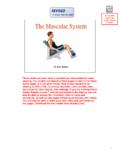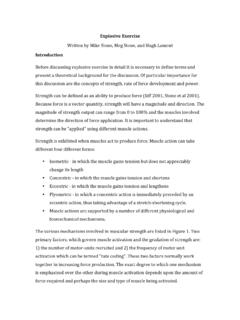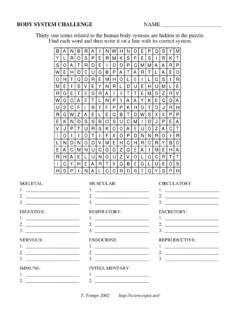Transcription of A review of equine muscle disorders - Home page | …
1 Neuromuscular disorders 18 (2008) 277 287. review A review of equine muscle disorders M. Aleman *. Department of Medicine and Epidemiology, Tupper Hall 2108, One Shields Avenue, School of Veterinary Medicine, University of California, Davis, CA 95616, USA. Received 8 September 2007; received in revised form 17 December 2007; accepted 6 January 2008. Abstract muscle disorders are a common cause of disability in horses. For many years, clinical manifestations such as muscle pain, exercise intolerance, weakness, and sti ness were believed to be caused by a single syndrome.
2 However, in the past years a broad spectrum of muscle disorders have been recognized including glycogen and polysaccharide storage myopathies, malignant hyperthermia, mitochon- drial myopathy, hyperkalemic periodic paralysis and others. For some, a speci c mutation has been identi ed. Recognition of the myo- pathic clinical phenotype and thorough clinical, electrodiagnostic, and histological evaluations are essential to further our understanding of equine myopathies. Advances in understanding equine myopathies may potentially bene t other species including humans.
3 2008 Elsevier All rights reserved. Keywords: equine ; Exertional; Myopathy; Myotonia; Rhabdomyolysis 1. Introduction as an animal model for human muscle diseases. disorders that a ect horses and man include equine motor neuron dis- muscle disorders are a common cause of disability in ease [11] with many similarities to human amyotrophic lat- a ected horses, and in the past, have been known by sev- eral sclerosis [12], malignant hyperthermia in Quarter eral names including tying up, Monday morning disease, Horses with a mutation in the calcium release channel of azoturia, equine rhabdomyolysis, and equine myoglobinu- the skeletal muscle sarcoplasmic reticulum, RyR1 gene [8], ria.
4 Although originally thought to be a single clinical syn- hyperkalemic periodic paralysis in Quarter Horses caused drome, it is now clear that these clinical manifestations are by a mutation in the a-subunit of the skeletal muscle sodium common to several di erent muscle disorders with di erent channel, SCN4A gene [2], and glycogen branching enzyme 1. etiologies [1]. In 1992 the rst hereditary muscle disease, de ciency in Quarter Horse and Paint foals due to a muta- hyperkalemic periodic paralysis in Quarter Horses, was tion in the glycogen branching enzyme 1, GBE1 gene [7].
5 Reported [2,3] and a genetic test is available for diagnosis. With increased recognition of the myopathic phenotype in Recently metabolic, in ammatory, dystrophic and other horses by veterinarians, and use of state-of-the-art histolog- inherited muscle diseases have been described in horses ical, biochemical and molecular techniques, the spectrum of [4 10]. A speci c genetic defect and mode of inheritance myopathies a ecting the horse will be greatly expanded. have only been identi ed in hyperkalemic periodic paraly- Known causes of equine myopathies are shown in Table sis [3], glycogen branching enzyme de ciency [7], and 1.
6 This classi cation separates myopathies into non-exer- malignant hyperthermia [8]. tional and exertional categories. These categories are fur- Horses have a number of muscle disorders which share ther divided into whether or not they are associated with similar clinical, histopathological and in some cases molecu- rhabdomyolysis. A nal category covers diseases associated lar features with humans. Thus the horse can be considered with altered membrane conduction. This review highlights the most important recognized muscle disorders in horses *. Tel.: +1 530 752 0290; fax: +1 530 752 9815.
7 With an emphasis on inherited, metabolic, toxic, and E-mail address: in ammatory myopathies. 0960-8966/$ - see front matter 2008 Elsevier All rights reserved. 278 M. Aleman / Neuromuscular disorders 18 (2008) 277 287. Table 1. Classi cation of myopathies in horses I. Non-exertional myopathies II. Exertional myopathies A. Rhabdomyolysis A. Rhabdomyolysis Nutritional Sporadic Vitamin E/selenium de ciency Lack of training Metabolic Overexertion Glycogen branching enzyme de ciency Heat exhaustion Polysaccharide storage myopathy Electrolyte imbalances Anesthesia associated Chronic Compartmental myopathy Dietary imbalances Malignant hyperthermia Polysaccharide storage myopathy Toxic Recurrent exertional rhabdomyolysis Pasture associated Idiopathic Drug/chemical associated Trauma Ionophore toxicosis Organophosphate toxicity B.
8 No rhabdomyolysis Trauma Mitochondrial myopathy In ammatory Complex I respiratory chain enzyme de ciency Infectious Pituitary pars intermedia dysfunction myopathy Viral, bacterial, parasitic Immune-mediated III. Altered muscle membrane conduction B. No rhabdomyolysis Electrolyte abnormalities Pituitary pars intermedia dysfunction myopathy Tetany (severe hypocalcemia). Steroid induced Others Disuse atrophy Hyperkalemic periodic paralysis muscle wasting associated with neoplasia Myotonic dystrophy Neoplasia (rare) Tick myotonia (ear tick: Otobius megnini). 2.
9 Non-exertional myopathies with rhabdomyolysis Peracute clinical signs in de cient foals include recum- bency, tachypnea, dyspnea, myalgia, arrhythmias, and sud- Selenium/vitamin E de ciency den death. In the subacute form, foals may show severe weakness, inability to stand, muscle fasciculations, rm Nutritional myodegeneration (also known as nutritional muscles on palpation, sti ness, stilted gait, myalgia, leth- muscular dystrophy, dystrophic myodegeneration, nutri- argy, dysphagia, trismus, ptyalism, and weak suckle re ex tional myodystrophy, or white muscle disease) is a peracute [15].
10 Failure of passive transfer, aspiration pneumonia, to subacute myodegenerative disease of cardiac and skele- and starvation are common complications. Important lab- tal muscle caused by a dietary de ciency of selenium and oratory alterations include markedly elevated serum crea- to a lesser extent vitamin E (a-tocopherol) [13]. Clinical tine kinase (CK) and aspartate aminotransferase (AST). manifestations occur mainly in young growing foals but activities, hyperproteinemia, azotemia, hyponatremia, can also occur in older horses. Selenium functions as a hypochloremia, hyperkalemia, hyperphosphatemia, respi- redox element and is a component of at least 35 selenopro- ratory acidosis, and myoglobinuria [17].





